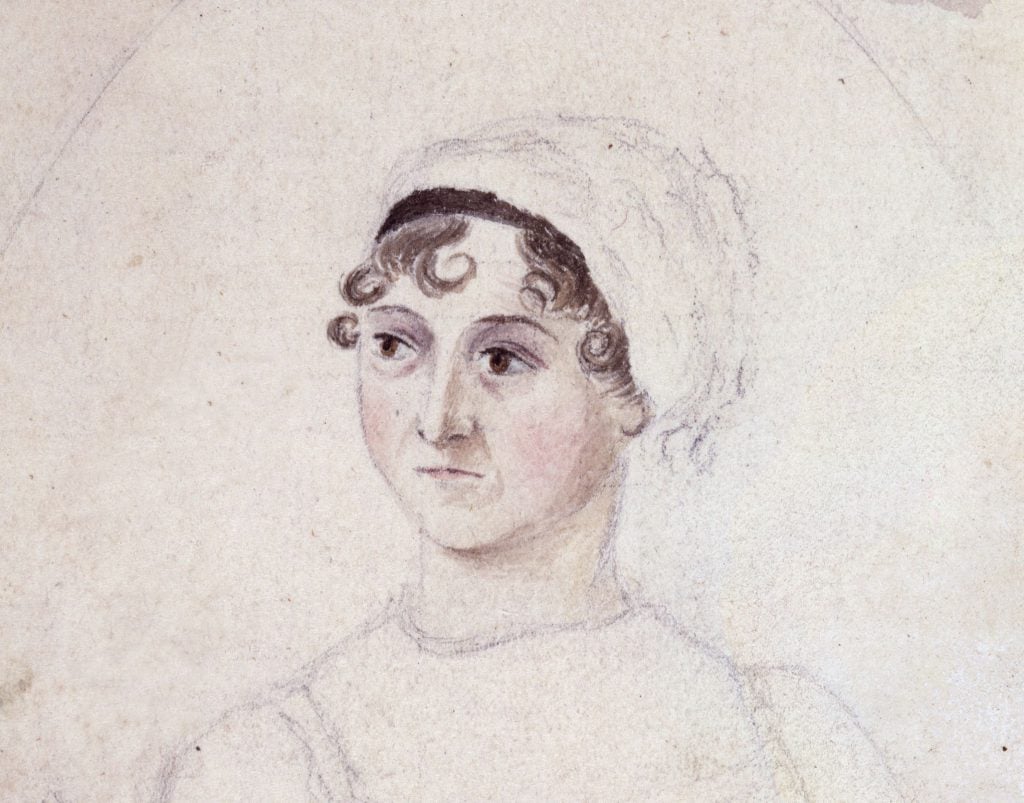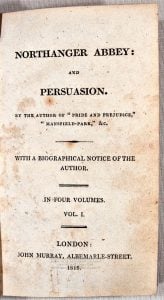
A sketch of Jane Austen by her sister Cassandra (c.1810). Source: Wikimedia Commons.
Jane Austen transcends time. Her work critiques 18th century England but it remains compelling to contemporary readers. Her terrific characters, realism, and her sense of irony and humour have earned Austen critical acclaim and a wide audience, inspiring countless readers and writers. All that for a writer who wrote anonymously throughout her entire career.
All about Austen

First edition of Jane Austen’s Northanger Abbey and Persuasion, 1818. Source: Wikimedia Commons.
Austen was born 16 December 1775 at Steventon Rectory, Hampshire. She died 18 July 1817 in Winchester. Austen began writing when she was young. From at least 11 years of age, she was penning poems and stories to amuse herself and her family.
Among these early works is a satirical novel in letters called Love and Friendship and The History of England, a caricature of school history books Austen wrote when she was 15 years old.
While The History of England was credited to “a partial, prejudiced, & ignorant Historian”, Austen’s first publication was credited as written “by a Lady”. It wasn’t until the posthumous publications of Persuasion and Northanger Abbey in 1818 that Austen was identified as the author of her works.
She may have spent her career as an anonymous writer but she’s now a household name: Austen’s novels have been continually in print since 1833.
Everyone may know Austen’s name but we don’t necessarily know much about her life and person. After Austen’s death her sister Cassandra destroyed many of her letters. Early biographical notes provided by her brother Henry and the first full biography of written by her nephew “sweeten” the Austen evident in those writings of hers which remain.
Austen adapted
Despite the limited knowledge we have of her as a person, Austen’s work and life have been adapted and adopted by many. The first dramatic adaptation, Duologues and Scenes from the Novels of Jane Austen: Arranged and Adapted for Drawing-Room Performance, was published in 1895.
The appropriation of her life and image as a romance writer has also spawned books and films including, Becoming Jane, Miss Austen Regrets, The Jane Austen Book Club and Austenland.
The first professional stage adaptation of Pride and Prejudice was in 1901. The first film adaptation of one of Austen’s books, also Pride and Prejudice, was made in 1940. It took over 50 years before the second with Ang Lee’s 1995 Sense and Sensibility.
The BBC have adapted all the novels for television, in some cases more than once. The 1995 BBC adaptation of Pride and Prejudice did much to increase Austen’s popularity but, in doing so, it also compromised her legacy as a writer. Its reinterpretation of the plot (the most famous scene in this adaptation is not actually in the book) has seen her categorized as a “chick lit” author, rather than the satirist and social critic she was.
Austen abiding
The genius and the longevity of her writing is in its realism and social commentary, as well as her use of irony and humour – “a rapier-like attack on convention and absurdity” according to Margaret Drabble. While much of her own life will remain unknown, her creations and their wit and truth will live on, providing enjoyment, insight and inspiration.
As everyone knows, any work possessing great quality must be in want of avid readers.


excellent, please publish more posts from Ms Krishna-Pillay